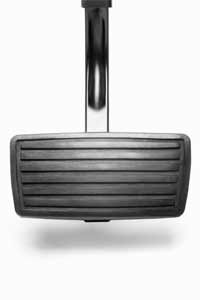If your brake light switch isn't working properly, there's a chance that you could be driving under risky conditions. Your brake lights may not light up when you press on the brake pedal or they may stay lit regardless of whether you're pressing the pedal or not. Or perhaps, some switch malfunction is causing the lights to operate intermittently. So you can see the problem: If you don't regularly check your brake lights for proper operation, you may be driving around town with no brake lights at all; brake lights that are continuously on; or brake lights that work only part of the time. Either way, it's dangerous to you and other drivers around you.
Before you get too anxious about the brake work that you may or may not need, you may want to investigate the problem yourself. Actually, it may be an easier fix than you think, just by investigating your brake light switch. You can see your brake light switch by looking under the dash, near the top of the brake pedal. The brake light switch is usually attached to a small bracket that holds the switch, activated when the pedal is depressed, in position.
Once you've located the switch, check to make sure that the brake light switch's electrical connection is firmly attached and that all of the wires connecting to the brake light switch are in good condition (at least as far as you can see from your position). Then check to make sure that the switch isn't out of position or stuck in the on or off position. Unless there's been a failure somewhere within the switch itself — a highly unlikely problem, by the way — it's relatively simple to decide if the switch is at fault.
If you're able to determine that it is indeed your brake light switch that's at fault, replacement is simple. In fact, it's likely that you won't even have to get your hands dirty to complete a brake repair of this sort. Remember, there are several different types of brake switches available, including hydraulic brake switches, so be sure to get the one that's right for your specific vehicle. You'll need to know the make, model and year of your vehicle. Your local auto parts store should be able to locate the correct part for you.
It may seem elementary, but remember that it's important to properly diagnose the problem prior to buying any repair parts. It won't do you any good to buy a new brake light switch if the problem is in the wiring leading up to the switch, in the connector itself or in the wiring that goes from the switch to the brake lights at the rear of the vehicle.
So as you can see, sometimes fixing brakes — or rather, fixing brake light wiring — doesn't have to be as complicated as it initially sounds. Read the next page to find out about connecting the brake lights themselves.







